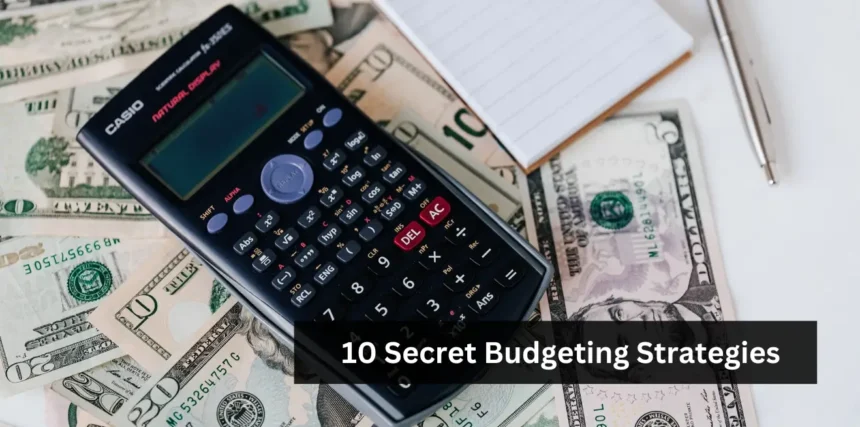Budgeting is often misunderstood as a restrictive practice, limiting your freedom to spend. Here is 10 Secret Budgeting Strategies, However, it’s a powerful tool for gaining control over your finances, enabling you to achieve your goals and secure your future. In this article, we will debunk common budgeting myths and introduce 10 secret strategies that can transform your financial life.
The Importance of Budgeting: Understanding the Impact on Your Financial Health
Budgeting isn’t just about tracking expenses or cutting back on coffee. It’s about understanding where your money goes and making conscious decisions to prioritize your financial health. A well-planned budget can lead to less stress, better debt management, and a clearer path to your financial goals.
Common Misconceptions About Budgeting
Many believe budgeting means never enjoying life’s pleasures. In reality, it’s about creating a plan to enjoy those pleasures without financial stress. It’s not a tool for restriction but a method for empowerment.
Here are the 10 Secret Budgeting Strategies you Can Follow
1. Zero-Based Budgeting
Start each month with a clean slate by allocating every dollar of your income to specific expenses, savings, and debt payments. This method ensures that every dollar is accounted for and can help prevent overspending.
Example: If your monthly income is $3,000, you allocate every dollar to specific expenses, savings, and debt. For instance, $1,000 might go towards rent, $500 towards groceries, $200 for utilities, $300 to savings, $200 to debt repayment, and the remaining $800 distributed among other necessary expenses. At the end of the month, you have allocated all $3,000, leaving a “zero” balance to start the next month’s budget.
2. The 50/30/20 Rule
Allocate your after-tax income into three categories: 50% for necessities, 30% for wants, and 20% for savings or paying off debt. This simple formula can help you quickly determine how much you can realistically spend and save each month.
Example: Say you take home $4,000 a month. According to the 50/30/20 rule, you’d allocate $2,000 (50%) for necessities like rent and food, $1,200 (30%) for wants like dining out and entertainment, and $800 (20%) for savings or paying down debt.
3. The Kakeibo Method
The Kakeibo method is a traditional Japanese budgeting system that’s been used for over a century. It translates to “household financial ledger” and is a simple, yet effective way to manage your finances and save money. The core idea behind Kakeibo is mindfulness about spending. It encourages you to think carefully about how and why you are using your money.
Here’s how it works:
- At the beginning of each month, you start by noting down your fixed income.
- Then, you subtract your essential expenses (like rent, utilities, groceries).
- The remaining amount is what you have left to save or spend.
The Kakeibo method then asks you to categorize your spending into four groups:
- Survival (essentials like food, medicine): Expenses you cannot avoid and must pay.
- Optional (wants like dining out, entertainment): Expenses you can avoid if needed.
- Culture (personal improvement like books, museum tickets): Expenses that enrich your mind or life.
- Extra (unexpected expenses like repairs, gifts): Expenses that are unforeseen and don’t fit into the other categories.
At the end of each month, you review what you spent and saved. The key part of Kakeibo is reflecting on these questions:
- How much money do you have?
- How much would you like to save?
- How much are you spending?
- How can you improve?
Example:
Let’s say your monthly take-home pay is $3,000.
- You start by deducting your fixed expenses (rent, utilities, insurance) which total $1,500.
- You’re left with $1,500 for the rest of the month.
- You set a savings goal of $300.
- Now, you have $1,200 to allocate to your Survival, Optional, Culture, and Extra categories.
Throughout the month, you track every expense in one of these categories. For instance:
- You spent $400 on groceries and medicine (Survival).
- You spent $200 on dining out with friends and a new video game (Optional).
- You spent $100 on books and a piano class (Culture).
- You had to unexpectedly repair your car for $150 (Extra).
At the end of the month:
- You’ve spent $850 of your $1,200. This means you’ve successfully saved $350, which is $50 more than your target.
By regularly reflecting on your spending with these categories and questions, the Kakeibo method helps you understand your financial habits better, make more mindful decisions about money, and ultimately, save more.
You Can Also Read: Mastering 18 Basics of Personal Finance Lessons
4. Cash Envelope System
The Cash Envelope System is a budgeting method popularized by personal finance experts like Dave Ramsey. It’s a simple and effective way to manage spending and save money by using physical cash and envelopes for different categories of your budget.
How the Cash Envelope System Works:
- Budget Categories: First, you determine the various categories where you regularly spend money each month, such as groceries, entertainment, dining out, transportation, and clothing.
- Allocate Cash: Once you’ve received your income, withdraw the total amount you’ve budgeted for these expenses in cash. Then, divide the cash into the envelopes, each labelled with a category name and the amount budgeted for that category.
- Spend From Envelopes: Throughout the month, you pay for your expenses out of the appropriate envelopes. For example, when you go grocery shopping, you take money from the “Groceries” envelope.
- Rules: Once an envelope is empty, you can’t spend any more money on that category for the rest of the month, unless you adjust your budget by taking cash from another envelope (but this is generally discouraged as it defeats the purpose of setting limits).
Example of the Cash Envelope System:
Let’s say your monthly take-home pay is $3,000, and you’ve decided to use the cash envelope system for the following categories:
- Groceries: $600
- Gas/Transportation: $200
- Entertainment: $150
- Dining Out: $100
- Clothing: $50
At the beginning of the month, you withdraw $1,100 in cash and divide it among the envelopes:
- “Groceries” envelope gets $600
- “Gas/Transportation” envelope gets $200
- “Entertainment” envelope gets $150
- “Dining Out” envelope gets $100
- “Clothing” envelope gets $50
During the Month:
- When you go to the supermarket, you bring your “Groceries” envelope and spend $120. You put the change back into the envelope, which now has $480 left for the rest of the month.
- You need to fill up your car and spend $40 from the “Gas/Transportation” envelope, leaving $160 for future refills.
- You’re invited out to a movie and use $30 from your “Entertainment” envelope, leaving $120 for other activities.
End of the Month:
You’ve successfully stayed within your budget for groceries and gas but noticed you’ve used up your dining out and entertainment budgets quicker than expected. You have $10 left in the clothing envelope, which you decide to save.
Reflection:
At the end of the month, you review your spending. You realize that maybe $100 for dining out wasn’t realistic and decide to adjust the amounts for next month. You also feel proud that you didn’t overspend on clothes and decide to put that leftover money into a small savings envelope.
Benefits of Cash Envelope System
The Cash Envelope System helps you visualize and control your spending. It’s particularly effective for people who tend to overspend with credit or debit cards because it forces you to confront your spending habits directly and adjust them in real-time. However, it requires discipline and regular monitoring to ensure you stay within your budget for each category.
5. Debt Snowball Method
Pay off your debts by starting with the smallest balance first while making minimum payments on the rest. As each debt is paid off, move on to the next smallest, building momentum and motivation.
Example: You have three debts: $500 on a credit card, $2,000 on a car loan, and $10,000 on a student loan. You focus all extra repayment on the $500 credit card debt while paying minimums on the others. Once the credit card is paid off, you tackle the car loan, and so on, building momentum as each debt is cleared.
6. Automate Savings
Set up automatic transfers from your checking account to a savings account. By making savings automatic, you’re less likely to spend the money you’ve earmarked for future needs.
Example: You decide to save $200 from each paycheck. You set up an automatic transfer from your checking account to a savings account every payday, so the $200 goes directly into savings before you have a chance to spend it.
7. Track Your Spending
Keep a detailed record of where every dollar goes. This can help you identify and cut back on unnecessary expenses. There are many apps and tools available that can simplify this process.
Example: After noticing your bank account balance was lower than expected, you start using an app to track expenses. You realize you’re spending $300 a month on coffee shops. Seeing this, you decide to cut back and make coffee at home, saving you hundreds of dollars.
8. Spend to Save
Invest in quality items that will last longer and save money in the long run, rather than opting for cheaper, lower-quality products that need to be replaced more frequently.
Example: Instead of buying a cheap $50 blender that might break in a year, you invest $150 in a high-quality model that lasts for 10 years. The initial cost is higher, but you save money in the long run by not needing to replace it frequently.
9. Avoid Lifestyle Inflation
As your income increases, maintain your standard of living and use the extra money to boost your savings or pay down debt.
Example: You get a $5,000 raise. Instead of moving into a more expensive apartment or buying a new car, you maintain your current standard of living and put the extra money towards your savings and investment goals.
10. Plan for Irregular Expenses
Set aside a little money each month for annual or semi-annual expenses, like insurance premiums or car maintenance, so these don’t disrupt your regular budget.
Example: You pay $600 for car insurance every six months. Rather than being surprised by the bill, you set aside $100 each month into a savings account designated for car insurance. When the bill comes, you can pay it in full without affecting that month’s budget.
Conclusion
We’ve covered 10 strategies to help you master your finances through effective budgeting. From setting a strong foundation to addressing common challenges and enhancing your skills, these strategies are designed to provide a comprehensive approach to budgeting. Now it’s your turn to take action and implement these tactics to achieve your financial goals.
Frequently Asked Questions – FAQ’s
Q.1 What’s the best budgeting strategy for someone with irregular income?
For irregular income, strategies like forecasting future expenses and the pay-yourself-first approach can provide stability and ensure savings.
Q.2 How often should I review and adjust my budget?
Review your budget monthly to adjust for any changes in income or expenses. Regular check-ins ensure you stay on track.
Q.3 Can budgeting help me get out of debt faster?
Absolutely. Strategies focused on debt, like the snowball or avalanche method, can expedite your journey to becoming debt-free.
How do I budget with a partner or family?
Communication is key. Regularly discuss goals, challenges, and progress. Consider using apps that allow for shared budget tracking.








